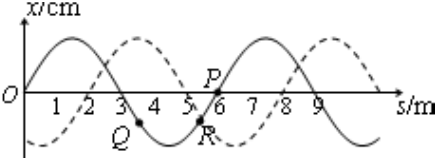已知在t1时刻简谐横波的波形如图中实线所示;在时刻t2该波的波形如图中虚线所示.t2-t1=0.02s,求:
(1)该波可能的传播速度.
(2)若已知T<t2-t1<2T,且图中P质点在t1时刻的瞬时速度方向向上,求可能的波速.
(3)若0.01s<T<0.02s,且从t1时刻起,图中Q质点比R质点先回到平衡位置,求可能的波速.

(1)若简谐横波是向右传播,在t2-t1内波形向右匀速传播最短距离为
λ1 3
根据波的周期性得波传播的距离为x=(n+
)λ,(n=0,1,2,…);1 3
波速v=
=x t
=100(3n+1)m/s (n=0,1,2,…);(n+
)λ1 3 t2-t1
同理可得若该波是向左传播的,可能的波速v=100(3n+2)m/s (n=0,1,2,…)
(2)P质点速度向上,说明波向左传播,T<t2-t1<2T,说明这段时间内波是向左传播了
个波长,5 3
则由第(1)问波速表达式v=100(3n+2)m/s (n=0,1,2,…)可知,n取1得到
v=500m/s
(3)“Q比R先回到平衡位置”,说明波是向右传播的.由题0.01s<T<0.02s,即
<T<t2-t1t2-t1 2
也就是T<t2-t1<2T,则这段时间内波只可能向右传播了
个波长,4 3
由第(1)问波速表达式v=100(3n+1)m/s (n=0,1,2,…)可知,n取1
得到v=400m/s.
答:(1)该波可能的传播速度为:若简谐横波是向右传播,波速v=100(3n+1)m/s (n=0,1,2,…);
若波是向左传播的,波速v=100(3n+2)m/s (n=0,1,2,…)
(2)若已知T<t2-t1<2T,且图中P质点在t1时刻的瞬时速度方向向上,可能的波速为500m/s.
(3)若0.01s<T<0.02s,且从t1时刻起,图中Q质点比R质点先回到平衡位置,可能的波速为400m/s.
